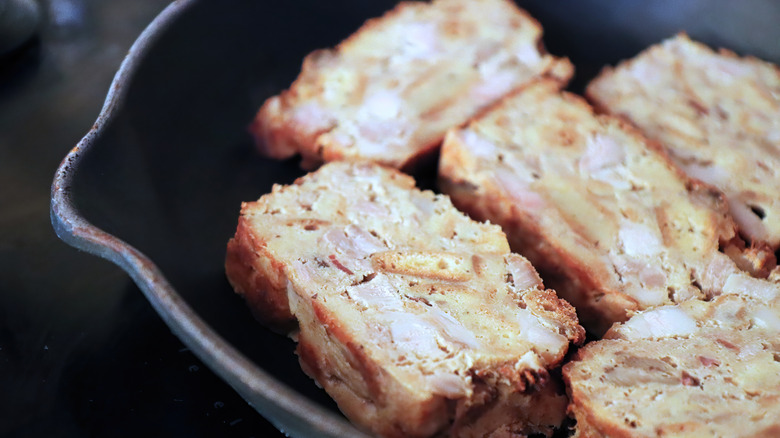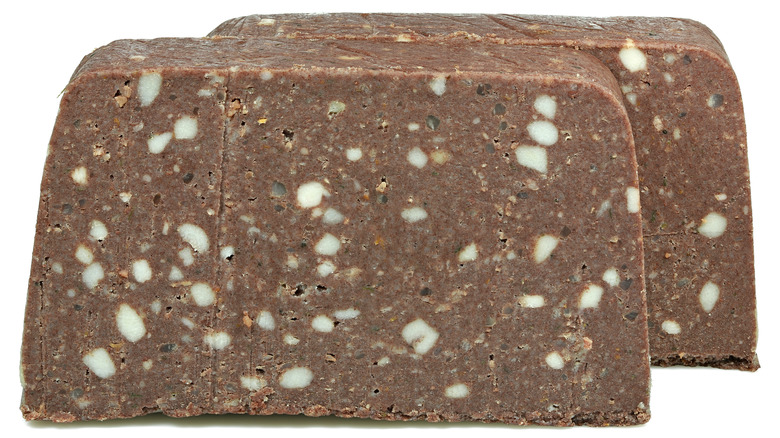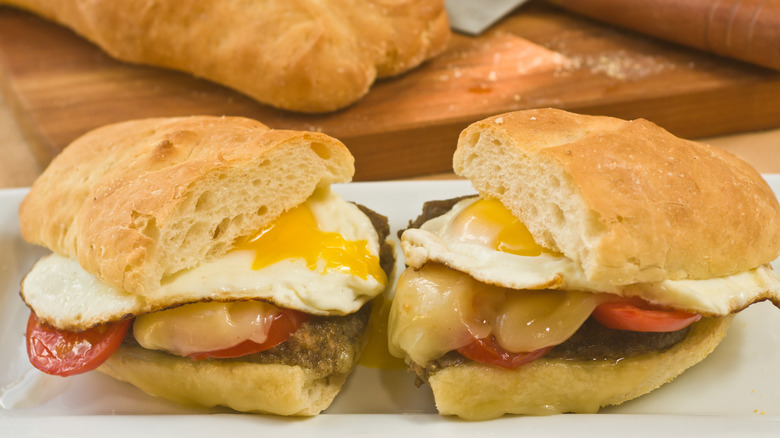How Scrapple Became A Pennsylvania Dutch Staple
At first glance, you might think scrapple is a slice of fried SPAM or even a pan-toasted piece of nutty bread. But scrapple is a unique food item that originated in Pennsylvania's Lancaster County, an area famous for its German origins and Amish community. Nicknamed "poor man's bacon," scrapple is a loaf-style meat product made from a mixture of ground pork, pork offal (organ meat), spices, and coarse flour or meal. Although fully cooked, it is generally cut into slices and fried or heated until browned and caramelized before eaten.
Making scrapple was a way to make use of the scraps and undesirable pieces of a butchered hog that would otherwise be discarded. The method of adding meal or flour to it was similar to why meatloaf contains bread or crackers — it stretches the volume of the meat. Producers of scrapple will simmer the pork meat and offal in water until it is very tender. Once done, the rest of the ingredients are mixed in along with pork stock to create a mixture. The mixture is then simmered until it's thick, poured into loaf pans for molding, and cooled.
The process has a mild resemblance to sausage-making, which makes sense, seeing as its pioneers were from the sausage capital of Europe: Germany.
Scrapple combines old-world recipes with new-world ingredients
In the 17th and 18th centuries, the southeastern part of Pennsylvania saw an influx of immigrants from Germany and Switzerland, many of whom were attracted to the region in part due to leader William Penn's tolerant religious principles. These newcomers brought their food and recipe knowledge from their country of origin to the New World, including how they processed meats.
Blood sausage has historically been popular in European countries and combines meat with organ meat and filler, such as oats, along with spices and blood. And it was the prototype for scrapple. Scrapple contains no blood but is similar to this type of meat in its other ingredients. The fact that scrapple often contains cornmeal — a very American ingredient — makes it unmistakably North American.
It's been said that the word "scrapple" comes from the German word "panhaskröppe," a combination of the words "panaas" (pan rabbit) and "skröppel" (slice of). While the German and Swiss populations thrived in the colony of Pennsylvania, so did scrapple. Its popularity soared through the centuries, and it remains a beloved regional dish today. Although it is still primarily associated with Pennsylvania, it can be found in other states and regions along the eastern seaboard with strong German influence, including Maryland, Delaware, New Jersey, New York, and Virginia.
It's not just for breakfast
In these areas, it's not uncommon to find scrapple in local grocery stores, Amish markets, and butcher shops. It is still produced and sold in loaf form, so it needs to be sliced in individual portions before it's eaten or prepared.
Scrapple is especially popular as a breakfast meat. It's pan-fried in butter or oil until crispy and served hot alongside eggs, toast, potatoes, pancakes or whatever else you eat for breakfast. (Speaking of breakfast, the brewers at Delaware-based Dogfish Head Brewery once created a breakfast stout made with scrapple.)
Still, scrapple is appropriate anytime, not just in the morning. Put a couple of fried slices in a sandwich for lunch, flour and deep-fry cubes of scrapple and serve them with a dipping sauce as an appetizer, or break it into chunks and make a hash or put on top of pizza. Similar to the way bacon or sausage tastes great dipped in maple syrup, scrapple can be served with sweet condiments, such as jams, applesauce, and honey. It also works well with hollandaise sauce, ketchup, and mustard. Scrapple for breakfast pairs well with a hot cup of coffee, but feel free to crack open a cold beer if eating it any other time of day. After all, if it's good enough to go in beer, surely it tastes great alongside it.



